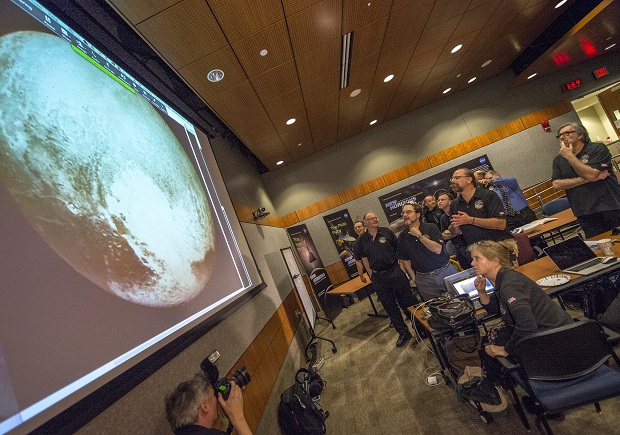Pluto flyby a success; Spacecraft survives 4.8B-km trip — NASA

Members of the New Horizons science team react to seeing the spacecraft’s last and sharpest image of Pluto before closest approach later in the day, Tuesday, July 14, 2015, at the Johns Hopkins University Applied Physics Laboratory (APL) in Laurel, Maryland. NASA’s New Horizons spacecraft was on track to zoom within 7,800 miles (12,500 kilometers) of Pluto on Tuesday. AP
LAUREL, Maryland, United States — NASA’s New Horizons survived its historic flyby of Pluto, the US space agency said Tuesday after receiving a long-awaited signal from the spacecraft that it was still intact.
“We are in lock with telemetry on the spacecraft,” said mission operations manager Alice Bowman, confirming that contact had been made with the spacecraft after a journey of three billion miles (4.8 billion kilometers).
The confirmation followed a day of both jubilation and tension as scientists anxiously waited for NASA’s New Horizons spacecraft to send word across 3 billion miles (4.8 billion kilometers) and confirm it got humanity’s first up-close look at Pluto.
READ: Pluto Facts: Tiny, icy world gets major attention
Before the confirmation, all indications were that the craft successfully made its flyby, and a cheering, flag-waving celebration swept over the mission operations center in Maryland. But confirmation was not expected to reach Earth from the edge of the solar system for another 13 hours, or about 9 p.m. EDT (0100 GMT).
The unprecedented encounter was the last stop on NASA’s grand tour of the planets over the past half-century. New Horizons arrived at the small icy world after an epic journey that began 9½ years ago, back when Pluto was still considered a full-fledged planet.
“This is truly a hallmark in human history,” said John Grunsfeld, NASA’s science mission chief. “It’s been an incredible voyage.”
According to NASA, the spacecraft the size of a baby grand piano swept to within 7,700 miles (12,400 kilometers) of Pluto at 31,000 mph (49,900 kph). The countdown to confirmation began as New Horizons went past the dwarf planet and began studying its far side.
To commemorate the moment of closest approach, scientists released the best picture yet of Pluto, taken on the eve of the flyby.
Even better images will start “raining” down on Earth beginning Wednesday, promised principal scientist Alan Stern. But he cautioned everyone to “stay tuned” until New Horizons contacted home.
It takes 4½ hours for signals to travel one-way between New Horizons and Earth. The message was due to go out late in the afternoon during a brief break in the spacecraft’s data-gathering frenzy.
“We’re counting” on good news, said Stern, a Southwest Research Institute planetary scientist. “But there’s a little bit of drama because this is true exploration. New Horizons is flying into the unknown.”
Jim Green, NASA’s planetary science director, admitted to being “on pins and needles” while waiting for New Horizons to tell flight controllers, “I made it!”
Among the possible dangers: space debris that could destroy the mission. But with the chances of a problem considered extremely low, scientists assembled at Johns Hopkins University’s Applied Physics Laboratory erupted in jubilation when the moment of closest approach occurred at 7:49 a.m. EDT (1149 GMT). The lab is the spacecraft’s developer and manager.
Joining in the hoopla were the two children of the late American astronomer who discovered Pluto in 1930, Clyde Tombaugh. Some of his ashes are aboard the spacecraft.
The White House and Congress offered congratulations, and British physicist Stephen Hawking was among the scientists weighing in.
“Hey, people of the world! Are you paying attention?” planetary scientist Carolyn Porco, part of the New Horizons’ imaging team, said on Twitter. “We have reached Pluto. We are exploring the hinterlands of the solar system. Rejoice!”
The U.S. is now the only nation to visit every planet in the solar system. Pluto was No. 9 in the lineup when New Horizons left Cape Canaveral, Florida, on Jan. 19, 2006, but was demoted seven months later to dwarf status.
Scientists in charge of the $720 million mission hope the new observations will restore Pluto’s honor.
Stern and other so-called plutophiles posed for the cameras giving nine-fingers-up “Pluto Salute.”
The picture of Pluto taken on Monday showed an icy, pockmarked world, peach-colored with a heart-shaped bright spot and darker areas around the equator.
“To see Pluto be revealed just before our eyes, it’s just fantastic,” said mission operations manager Alice Bowman.
The Hubble Space Telescope had offered up the best pre-New Horizons pictures of Pluto, but they were essentially pixelated blobs of light.
Flight controllers held off on having New Horizons send back flyby photos until well after the maneuver was complete; they wanted the seven science instruments to take full advantage of the encounter.
New Horizons is also expected to beam back photos of Pluto’s big moon, Charon, and observe its four little moons. It will take 16 months, or until late 2016, for all the data to reach Earth.
On the eve of the encounter, NASA confirmed that Pluto is, indeed, the King of the Kuiper Belt. New measurements made by the spacecraft show that Pluto is 1,473 miles (2,370 kilometers) in diameter, or about 50 miles (80 kilometers) bigger than estimated.
That’s still puny by solar-system standards. Pluto is just two-thirds the size of Earth’s moon. But it is big enough to be the largest object in the Kuiper Belt, a zone rife with comets and tens of thousands of other small bodies.
Stern and his colleagues wasted no time pressing the U.S. Postal Service for a new stamp of Pluto.
The last one, issued in 1991, presented an artist’s rendering of the faraway world and the words: “Pluto Not Yet Explored.” The words “not yet” were crossed out in a poster held high Tuesday for the cameras.
___
Online:
NASA: https://www.nasa.gov/mission_pages/newhorizons/main/
Johns Hopkins University: https://pluto.jhuapl.edu